Consideration of patient situation Case Study 2022
VerifiedAdded on 2022/09/29
|10
|2556
|38
AI Summary
Contribute Materials
Your contribution can guide someone’s learning journey. Share your
documents today.

Assessment task 3: Case study – Perioperative
Consideration of patient situation
Mrs. Jane Austin is a 59-year-old woman presented to the emergency department with
complaints of several episodes of severe right upper quadrant abdominal pain associated with
uncontrolled nausea and vomiting. On admission, she was febrile, right upper quadrant
tenderness on palpation. She was diagnosed with cholelithiasis and cholecystitis via
ultrasound. She is admitted to the operating theater for laparoscopic cholecystectomy under
general anesthesia. During the Perioperative nursing care, the patient had some mild
hemodynamic instability during the insufflations and maintenance of pneum-operitoneum.
Collection of information
Mrs. Austin has a past medical history of hyperlipidemia, hypertension, and a body mass
index of 28 and is a smoker. Her present complaint is several episodes of severe right upper
quadrant abdominal pain associated with nausea and vomiting. On assessment, she has
tachycardia, febrile and complained of upper quadrant tenderness on palpation. She also has
the complaints of recent intolerance to fatty foods, resulting in nausea when ingested. A dual
diagnosis of cholelithiasis and cholecystitis was made by ultrasound. The treatment plan for
Austin is a laparoscopic cholecystectomy under general anesthesia.
Observation, auscultation, palpitation and blood investigations are done to rule out the
condition of the patient. On observing the level of consciousness she was alert and awake. On
auscultation over the chest shows the absence of air entry to the base. Gastrointestinal
auscultation shows the absence of bowel sounds. On palpation over the abdomen, mild
Consideration of patient situation
Mrs. Jane Austin is a 59-year-old woman presented to the emergency department with
complaints of several episodes of severe right upper quadrant abdominal pain associated with
uncontrolled nausea and vomiting. On admission, she was febrile, right upper quadrant
tenderness on palpation. She was diagnosed with cholelithiasis and cholecystitis via
ultrasound. She is admitted to the operating theater for laparoscopic cholecystectomy under
general anesthesia. During the Perioperative nursing care, the patient had some mild
hemodynamic instability during the insufflations and maintenance of pneum-operitoneum.
Collection of information
Mrs. Austin has a past medical history of hyperlipidemia, hypertension, and a body mass
index of 28 and is a smoker. Her present complaint is several episodes of severe right upper
quadrant abdominal pain associated with nausea and vomiting. On assessment, she has
tachycardia, febrile and complained of upper quadrant tenderness on palpation. She also has
the complaints of recent intolerance to fatty foods, resulting in nausea when ingested. A dual
diagnosis of cholelithiasis and cholecystitis was made by ultrasound. The treatment plan for
Austin is a laparoscopic cholecystectomy under general anesthesia.
Observation, auscultation, palpitation and blood investigations are done to rule out the
condition of the patient. On observing the level of consciousness she was alert and awake. On
auscultation over the chest shows the absence of air entry to the base. Gastrointestinal
auscultation shows the absence of bowel sounds. On palpation over the abdomen, mild
Secure Best Marks with AI Grader
Need help grading? Try our AI Grader for instant feedback on your assignments.
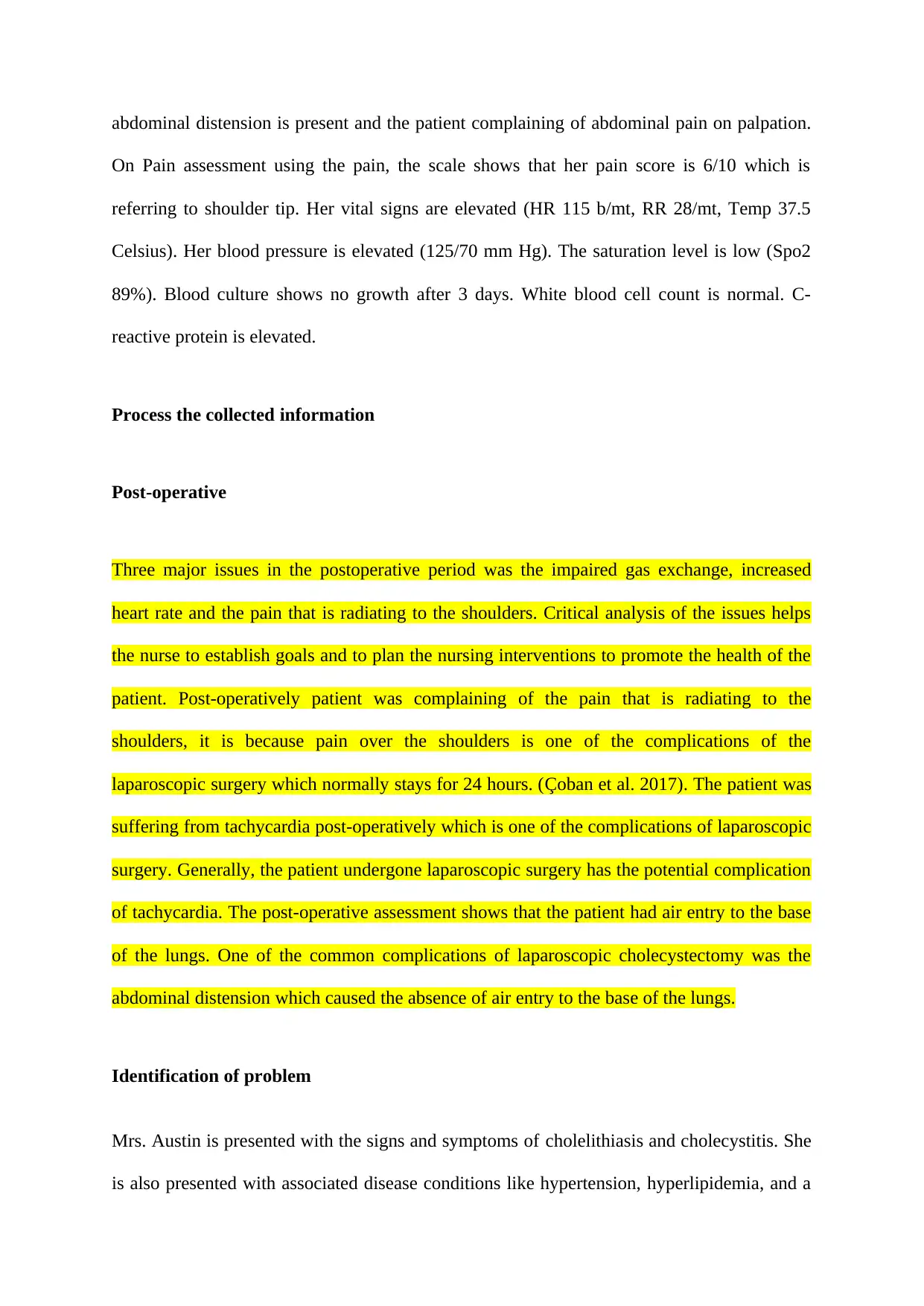
abdominal distension is present and the patient complaining of abdominal pain on palpation.
On Pain assessment using the pain, the scale shows that her pain score is 6/10 which is
referring to shoulder tip. Her vital signs are elevated (HR 115 b/mt, RR 28/mt, Temp 37.5
Celsius). Her blood pressure is elevated (125/70 mm Hg). The saturation level is low (Spo2
89%). Blood culture shows no growth after 3 days. White blood cell count is normal. C-
reactive protein is elevated.
Process the collected information
Post-operative
Three major issues in the postoperative period was the impaired gas exchange, increased
heart rate and the pain that is radiating to the shoulders. Critical analysis of the issues helps
the nurse to establish goals and to plan the nursing interventions to promote the health of the
patient. Post-operatively patient was complaining of the pain that is radiating to the
shoulders, it is because pain over the shoulders is one of the complications of the
laparoscopic surgery which normally stays for 24 hours. (Çoban et al. 2017). The patient was
suffering from tachycardia post-operatively which is one of the complications of laparoscopic
surgery. Generally, the patient undergone laparoscopic surgery has the potential complication
of tachycardia. The post-operative assessment shows that the patient had air entry to the base
of the lungs. One of the common complications of laparoscopic cholecystectomy was the
abdominal distension which caused the absence of air entry to the base of the lungs.
Identification of problem
Mrs. Austin is presented with the signs and symptoms of cholelithiasis and cholecystitis. She
is also presented with associated disease conditions like hypertension, hyperlipidemia, and a
On Pain assessment using the pain, the scale shows that her pain score is 6/10 which is
referring to shoulder tip. Her vital signs are elevated (HR 115 b/mt, RR 28/mt, Temp 37.5
Celsius). Her blood pressure is elevated (125/70 mm Hg). The saturation level is low (Spo2
89%). Blood culture shows no growth after 3 days. White blood cell count is normal. C-
reactive protein is elevated.
Process the collected information
Post-operative
Three major issues in the postoperative period was the impaired gas exchange, increased
heart rate and the pain that is radiating to the shoulders. Critical analysis of the issues helps
the nurse to establish goals and to plan the nursing interventions to promote the health of the
patient. Post-operatively patient was complaining of the pain that is radiating to the
shoulders, it is because pain over the shoulders is one of the complications of the
laparoscopic surgery which normally stays for 24 hours. (Çoban et al. 2017). The patient was
suffering from tachycardia post-operatively which is one of the complications of laparoscopic
surgery. Generally, the patient undergone laparoscopic surgery has the potential complication
of tachycardia. The post-operative assessment shows that the patient had air entry to the base
of the lungs. One of the common complications of laparoscopic cholecystectomy was the
abdominal distension which caused the absence of air entry to the base of the lungs.
Identification of problem
Mrs. Austin is presented with the signs and symptoms of cholelithiasis and cholecystitis. She
is also presented with associated disease conditions like hypertension, hyperlipidemia, and a

body mass index of 28. The nursing problems identified in the case scenario are impaired
patent airway related to high body mass index and anesthesia, impaired breathing related to
anesthesia and hypertension related to age and increased body mass index.
Impaired patent airway
The perioperative assessment shows that vital signs are elevated. Increased breathing (RR
28/mt) and decreased saturation levels (Spo2 89%) show that the airway is not patent.
Saturation represents the oxygen concentration in the blood. Decreased saturation shows that
the oxygen exchange is abnormal (Pascoal et al. 2016). Auscultation on the chest shows that
there is a lack of air entry to the base of the lungs which is one of the signs for impaired
airway patency. The airway is the high priority nursing problem that has to be treated
immediately to prevent further complications (Çoban et al. 2017). The nurse has to find the
causative factor of the impaired airway patency to establish the goals and plan the nursing
interventions. The main causes of impaired patent airway are age, increased body weight,
hyperlipidemia, and hypertension. The nurse needs to consider the contributory factors and
alleviate the factors to ensure the patent's airway (Edmark et al. 2015).
Impaired breathing
Impaired breathing is the second priority nursing problem that needs to be taken care of in the
case of Mrs. Austin. The Perioperative period is the stage that the nurse has to do close
monitoring and implement nursing interventions that improve the patient’s condition. The
patient’s vital signs are abnormal. Her respiratory rate is elevated (RR 28/mt). The saturation
level of the patient is decreased (Spo2 89%). Decreased Saturation level shows that oxygen
concentration in the blood is low. Low saturation levels lead to impaired tissue perfusion
patent airway related to high body mass index and anesthesia, impaired breathing related to
anesthesia and hypertension related to age and increased body mass index.
Impaired patent airway
The perioperative assessment shows that vital signs are elevated. Increased breathing (RR
28/mt) and decreased saturation levels (Spo2 89%) show that the airway is not patent.
Saturation represents the oxygen concentration in the blood. Decreased saturation shows that
the oxygen exchange is abnormal (Pascoal et al. 2016). Auscultation on the chest shows that
there is a lack of air entry to the base of the lungs which is one of the signs for impaired
airway patency. The airway is the high priority nursing problem that has to be treated
immediately to prevent further complications (Çoban et al. 2017). The nurse has to find the
causative factor of the impaired airway patency to establish the goals and plan the nursing
interventions. The main causes of impaired patent airway are age, increased body weight,
hyperlipidemia, and hypertension. The nurse needs to consider the contributory factors and
alleviate the factors to ensure the patent's airway (Edmark et al. 2015).
Impaired breathing
Impaired breathing is the second priority nursing problem that needs to be taken care of in the
case of Mrs. Austin. The Perioperative period is the stage that the nurse has to do close
monitoring and implement nursing interventions that improve the patient’s condition. The
patient’s vital signs are abnormal. Her respiratory rate is elevated (RR 28/mt). The saturation
level of the patient is decreased (Spo2 89%). Decreased Saturation level shows that oxygen
concentration in the blood is low. Low saturation levels lead to impaired tissue perfusion
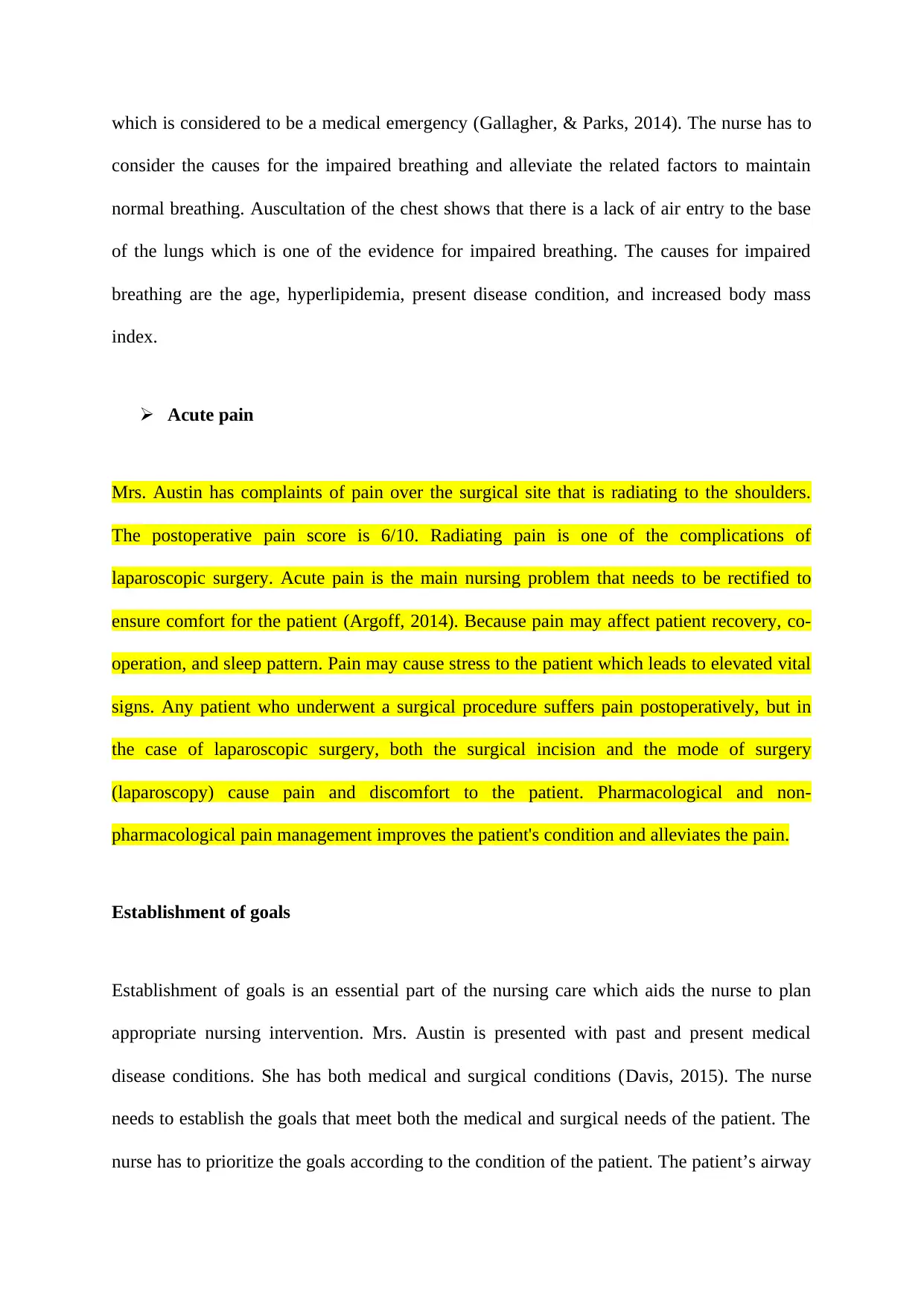
which is considered to be a medical emergency (Gallagher, & Parks, 2014). The nurse has to
consider the causes for the impaired breathing and alleviate the related factors to maintain
normal breathing. Auscultation of the chest shows that there is a lack of air entry to the base
of the lungs which is one of the evidence for impaired breathing. The causes for impaired
breathing are the age, hyperlipidemia, present disease condition, and increased body mass
index.
Acute pain
Mrs. Austin has complaints of pain over the surgical site that is radiating to the shoulders.
The postoperative pain score is 6/10. Radiating pain is one of the complications of
laparoscopic surgery. Acute pain is the main nursing problem that needs to be rectified to
ensure comfort for the patient (Argoff, 2014). Because pain may affect patient recovery, co-
operation, and sleep pattern. Pain may cause stress to the patient which leads to elevated vital
signs. Any patient who underwent a surgical procedure suffers pain postoperatively, but in
the case of laparoscopic surgery, both the surgical incision and the mode of surgery
(laparoscopy) cause pain and discomfort to the patient. Pharmacological and non-
pharmacological pain management improves the patient's condition and alleviates the pain.
Establishment of goals
Establishment of goals is an essential part of the nursing care which aids the nurse to plan
appropriate nursing intervention. Mrs. Austin is presented with past and present medical
disease conditions. She has both medical and surgical conditions (Davis, 2015). The nurse
needs to establish the goals that meet both the medical and surgical needs of the patient. The
nurse has to prioritize the goals according to the condition of the patient. The patient’s airway
consider the causes for the impaired breathing and alleviate the related factors to maintain
normal breathing. Auscultation of the chest shows that there is a lack of air entry to the base
of the lungs which is one of the evidence for impaired breathing. The causes for impaired
breathing are the age, hyperlipidemia, present disease condition, and increased body mass
index.
Acute pain
Mrs. Austin has complaints of pain over the surgical site that is radiating to the shoulders.
The postoperative pain score is 6/10. Radiating pain is one of the complications of
laparoscopic surgery. Acute pain is the main nursing problem that needs to be rectified to
ensure comfort for the patient (Argoff, 2014). Because pain may affect patient recovery, co-
operation, and sleep pattern. Pain may cause stress to the patient which leads to elevated vital
signs. Any patient who underwent a surgical procedure suffers pain postoperatively, but in
the case of laparoscopic surgery, both the surgical incision and the mode of surgery
(laparoscopy) cause pain and discomfort to the patient. Pharmacological and non-
pharmacological pain management improves the patient's condition and alleviates the pain.
Establishment of goals
Establishment of goals is an essential part of the nursing care which aids the nurse to plan
appropriate nursing intervention. Mrs. Austin is presented with past and present medical
disease conditions. She has both medical and surgical conditions (Davis, 2015). The nurse
needs to establish the goals that meet both the medical and surgical needs of the patient. The
nurse has to prioritize the goals according to the condition of the patient. The patient’s airway
Secure Best Marks with AI Grader
Need help grading? Try our AI Grader for instant feedback on your assignments.
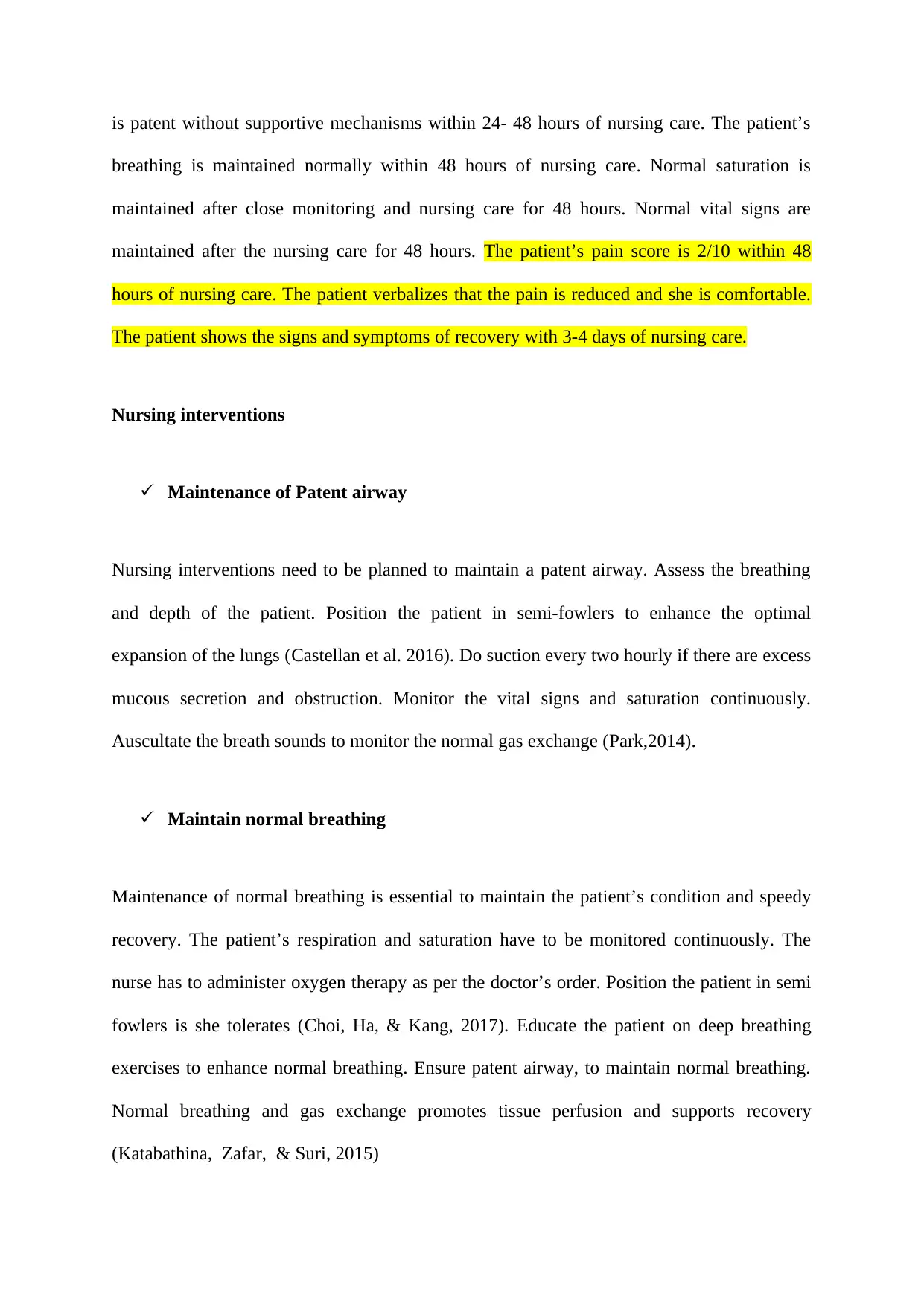
is patent without supportive mechanisms within 24- 48 hours of nursing care. The patient’s
breathing is maintained normally within 48 hours of nursing care. Normal saturation is
maintained after close monitoring and nursing care for 48 hours. Normal vital signs are
maintained after the nursing care for 48 hours. The patient’s pain score is 2/10 within 48
hours of nursing care. The patient verbalizes that the pain is reduced and she is comfortable.
The patient shows the signs and symptoms of recovery with 3-4 days of nursing care.
Nursing interventions
Maintenance of Patent airway
Nursing interventions need to be planned to maintain a patent airway. Assess the breathing
and depth of the patient. Position the patient in semi-fowlers to enhance the optimal
expansion of the lungs (Castellan et al. 2016). Do suction every two hourly if there are excess
mucous secretion and obstruction. Monitor the vital signs and saturation continuously.
Auscultate the breath sounds to monitor the normal gas exchange (Park,2014).
Maintain normal breathing
Maintenance of normal breathing is essential to maintain the patient’s condition and speedy
recovery. The patient’s respiration and saturation have to be monitored continuously. The
nurse has to administer oxygen therapy as per the doctor’s order. Position the patient in semi
fowlers is she tolerates (Choi, Ha, & Kang, 2017). Educate the patient on deep breathing
exercises to enhance normal breathing. Ensure patent airway, to maintain normal breathing.
Normal breathing and gas exchange promotes tissue perfusion and supports recovery
(Katabathina, Zafar, & Suri, 2015)
breathing is maintained normally within 48 hours of nursing care. Normal saturation is
maintained after close monitoring and nursing care for 48 hours. Normal vital signs are
maintained after the nursing care for 48 hours. The patient’s pain score is 2/10 within 48
hours of nursing care. The patient verbalizes that the pain is reduced and she is comfortable.
The patient shows the signs and symptoms of recovery with 3-4 days of nursing care.
Nursing interventions
Maintenance of Patent airway
Nursing interventions need to be planned to maintain a patent airway. Assess the breathing
and depth of the patient. Position the patient in semi-fowlers to enhance the optimal
expansion of the lungs (Castellan et al. 2016). Do suction every two hourly if there are excess
mucous secretion and obstruction. Monitor the vital signs and saturation continuously.
Auscultate the breath sounds to monitor the normal gas exchange (Park,2014).
Maintain normal breathing
Maintenance of normal breathing is essential to maintain the patient’s condition and speedy
recovery. The patient’s respiration and saturation have to be monitored continuously. The
nurse has to administer oxygen therapy as per the doctor’s order. Position the patient in semi
fowlers is she tolerates (Choi, Ha, & Kang, 2017). Educate the patient on deep breathing
exercises to enhance normal breathing. Ensure patent airway, to maintain normal breathing.
Normal breathing and gas exchange promotes tissue perfusion and supports recovery
(Katabathina, Zafar, & Suri, 2015)
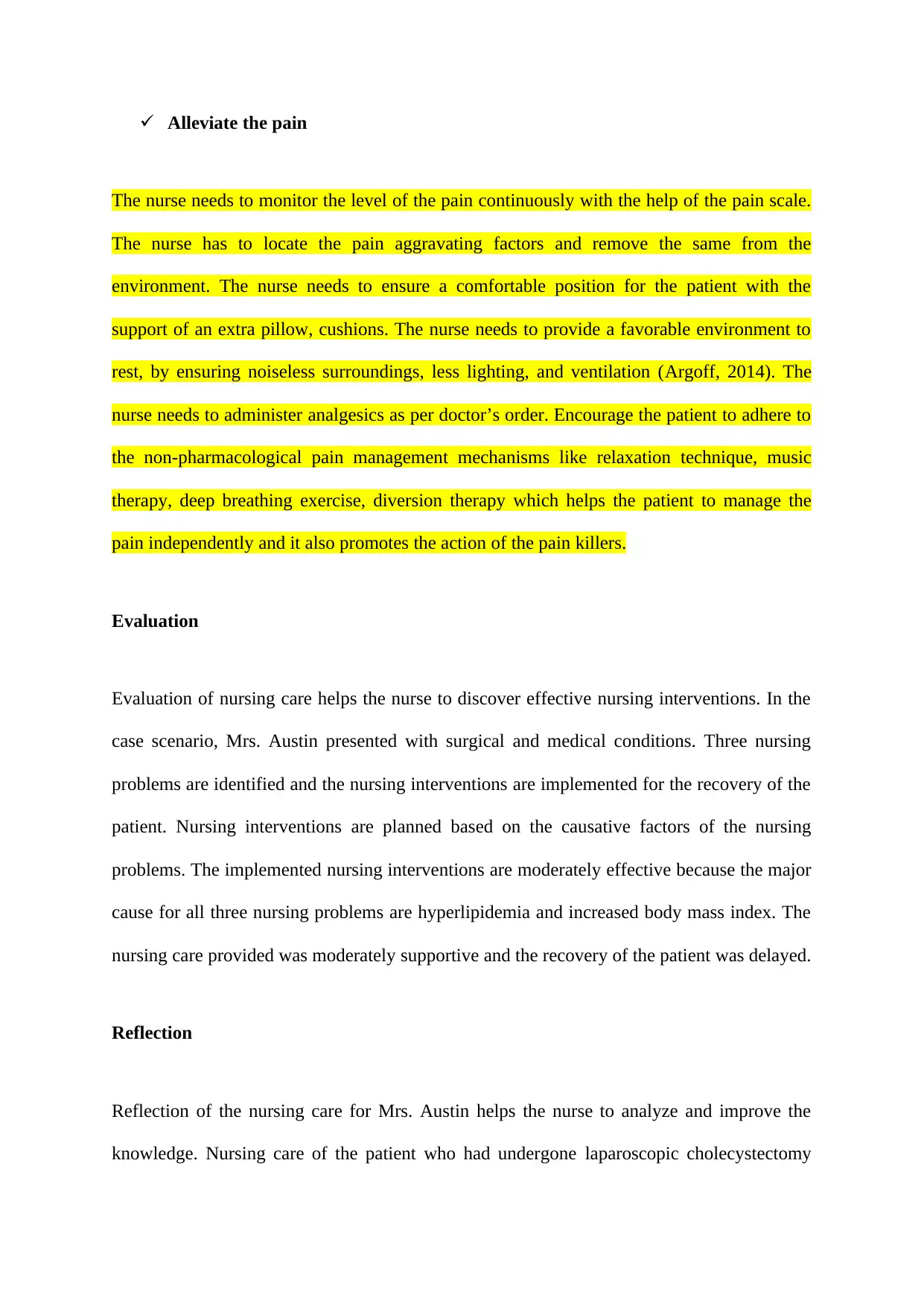
Alleviate the pain
The nurse needs to monitor the level of the pain continuously with the help of the pain scale.
The nurse has to locate the pain aggravating factors and remove the same from the
environment. The nurse needs to ensure a comfortable position for the patient with the
support of an extra pillow, cushions. The nurse needs to provide a favorable environment to
rest, by ensuring noiseless surroundings, less lighting, and ventilation (Argoff, 2014). The
nurse needs to administer analgesics as per doctor’s order. Encourage the patient to adhere to
the non-pharmacological pain management mechanisms like relaxation technique, music
therapy, deep breathing exercise, diversion therapy which helps the patient to manage the
pain independently and it also promotes the action of the pain killers.
Evaluation
Evaluation of nursing care helps the nurse to discover effective nursing interventions. In the
case scenario, Mrs. Austin presented with surgical and medical conditions. Three nursing
problems are identified and the nursing interventions are implemented for the recovery of the
patient. Nursing interventions are planned based on the causative factors of the nursing
problems. The implemented nursing interventions are moderately effective because the major
cause for all three nursing problems are hyperlipidemia and increased body mass index. The
nursing care provided was moderately supportive and the recovery of the patient was delayed.
Reflection
Reflection of the nursing care for Mrs. Austin helps the nurse to analyze and improve the
knowledge. Nursing care of the patient who had undergone laparoscopic cholecystectomy
The nurse needs to monitor the level of the pain continuously with the help of the pain scale.
The nurse has to locate the pain aggravating factors and remove the same from the
environment. The nurse needs to ensure a comfortable position for the patient with the
support of an extra pillow, cushions. The nurse needs to provide a favorable environment to
rest, by ensuring noiseless surroundings, less lighting, and ventilation (Argoff, 2014). The
nurse needs to administer analgesics as per doctor’s order. Encourage the patient to adhere to
the non-pharmacological pain management mechanisms like relaxation technique, music
therapy, deep breathing exercise, diversion therapy which helps the patient to manage the
pain independently and it also promotes the action of the pain killers.
Evaluation
Evaluation of nursing care helps the nurse to discover effective nursing interventions. In the
case scenario, Mrs. Austin presented with surgical and medical conditions. Three nursing
problems are identified and the nursing interventions are implemented for the recovery of the
patient. Nursing interventions are planned based on the causative factors of the nursing
problems. The implemented nursing interventions are moderately effective because the major
cause for all three nursing problems are hyperlipidemia and increased body mass index. The
nursing care provided was moderately supportive and the recovery of the patient was delayed.
Reflection
Reflection of the nursing care for Mrs. Austin helps the nurse to analyze and improve the
knowledge. Nursing care of the patient who had undergone laparoscopic cholecystectomy
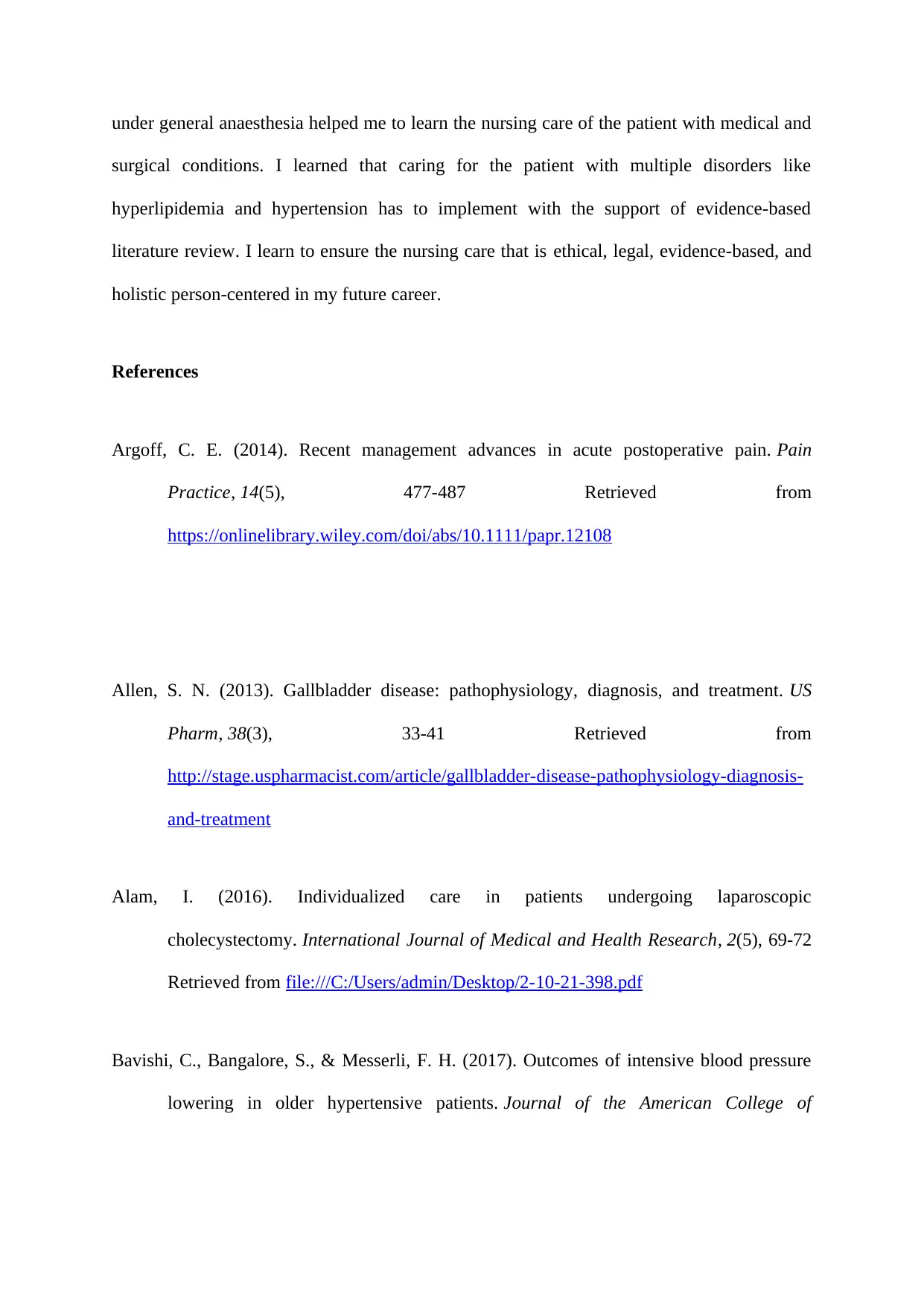
under general anaesthesia helped me to learn the nursing care of the patient with medical and
surgical conditions. I learned that caring for the patient with multiple disorders like
hyperlipidemia and hypertension has to implement with the support of evidence-based
literature review. I learn to ensure the nursing care that is ethical, legal, evidence-based, and
holistic person-centered in my future career.
References
Argoff, C. E. (2014). Recent management advances in acute postoperative pain. Pain
Practice, 14(5), 477-487 Retrieved from
https://onlinelibrary.wiley.com/doi/abs/10.1111/papr.12108
Allen, S. N. (2013). Gallbladder disease: pathophysiology, diagnosis, and treatment. US
Pharm, 38(3), 33-41 Retrieved from
http://stage.uspharmacist.com/article/gallbladder-disease-pathophysiology-diagnosis-
and-treatment
Alam, I. (2016). Individualized care in patients undergoing laparoscopic
cholecystectomy. International Journal of Medical and Health Research, 2(5), 69-72
Retrieved from file:///C:/Users/admin/Desktop/2-10-21-398.pdf
Bavishi, C., Bangalore, S., & Messerli, F. H. (2017). Outcomes of intensive blood pressure
lowering in older hypertensive patients. Journal of the American College of
surgical conditions. I learned that caring for the patient with multiple disorders like
hyperlipidemia and hypertension has to implement with the support of evidence-based
literature review. I learn to ensure the nursing care that is ethical, legal, evidence-based, and
holistic person-centered in my future career.
References
Argoff, C. E. (2014). Recent management advances in acute postoperative pain. Pain
Practice, 14(5), 477-487 Retrieved from
https://onlinelibrary.wiley.com/doi/abs/10.1111/papr.12108
Allen, S. N. (2013). Gallbladder disease: pathophysiology, diagnosis, and treatment. US
Pharm, 38(3), 33-41 Retrieved from
http://stage.uspharmacist.com/article/gallbladder-disease-pathophysiology-diagnosis-
and-treatment
Alam, I. (2016). Individualized care in patients undergoing laparoscopic
cholecystectomy. International Journal of Medical and Health Research, 2(5), 69-72
Retrieved from file:///C:/Users/admin/Desktop/2-10-21-398.pdf
Bavishi, C., Bangalore, S., & Messerli, F. H. (2017). Outcomes of intensive blood pressure
lowering in older hypertensive patients. Journal of the American College of
Paraphrase This Document
Need a fresh take? Get an instant paraphrase of this document with our AI Paraphraser
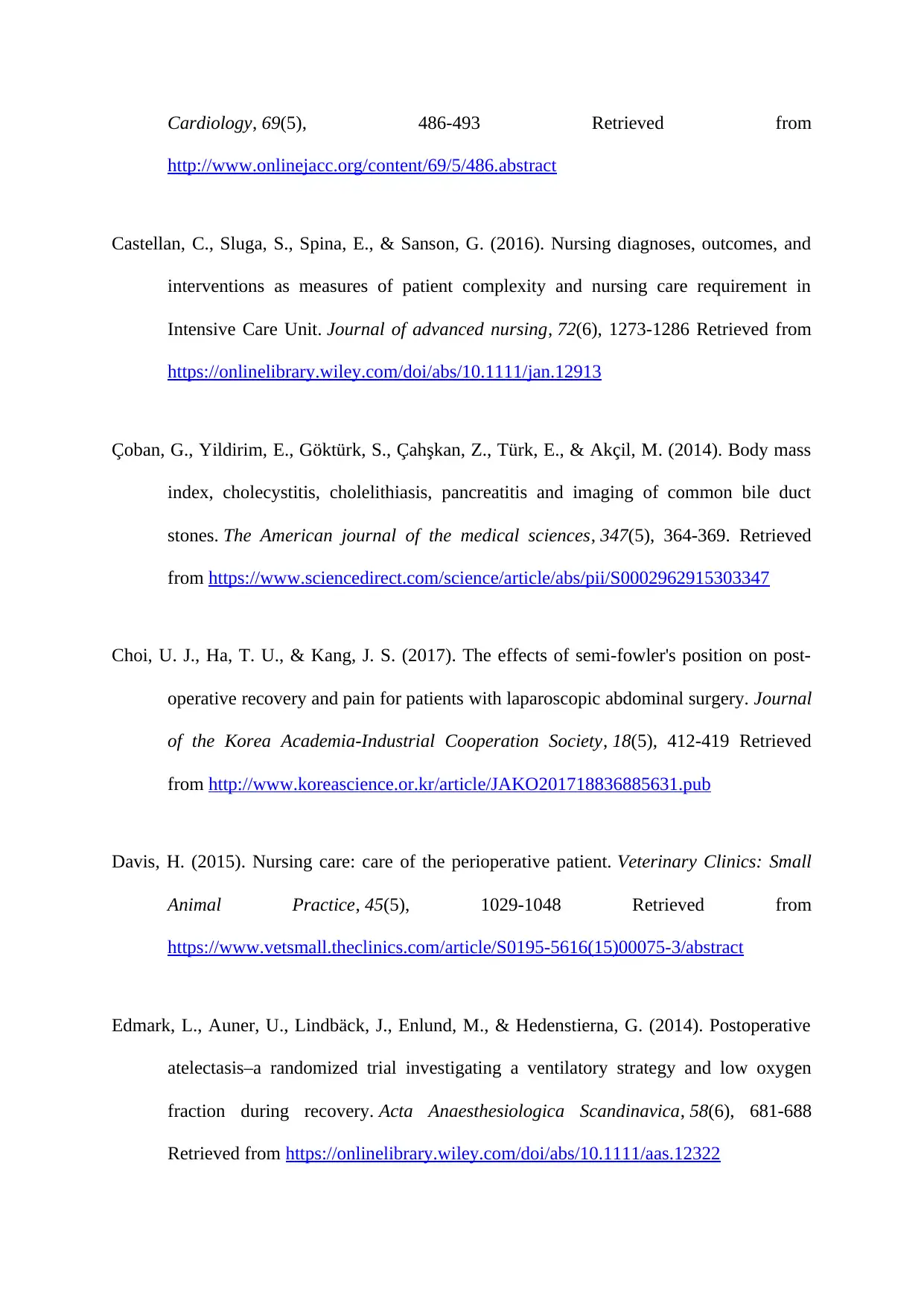
Cardiology, 69(5), 486-493 Retrieved from
http://www.onlinejacc.org/content/69/5/486.abstract
Castellan, C., Sluga, S., Spina, E., & Sanson, G. (2016). Nursing diagnoses, outcomes, and
interventions as measures of patient complexity and nursing care requirement in
Intensive Care Unit. Journal of advanced nursing, 72(6), 1273-1286 Retrieved from
https://onlinelibrary.wiley.com/doi/abs/10.1111/jan.12913
Çoban, G., Yildirim, E., Göktürk, S., Çahşkan, Z., Türk, E., & Akçil, M. (2014). Body mass
index, cholecystitis, cholelithiasis, pancreatitis and imaging of common bile duct
stones. The American journal of the medical sciences, 347(5), 364-369. Retrieved
from https://www.sciencedirect.com/science/article/abs/pii/S0002962915303347
Choi, U. J., Ha, T. U., & Kang, J. S. (2017). The effects of semi-fowler's position on post-
operative recovery and pain for patients with laparoscopic abdominal surgery. Journal
of the Korea Academia-Industrial Cooperation Society, 18(5), 412-419 Retrieved
from http://www.koreascience.or.kr/article/JAKO201718836885631.pub
Davis, H. (2015). Nursing care: care of the perioperative patient. Veterinary Clinics: Small
Animal Practice, 45(5), 1029-1048 Retrieved from
https://www.vetsmall.theclinics.com/article/S0195-5616(15)00075-3/abstract
Edmark, L., Auner, U., Lindbäck, J., Enlund, M., & Hedenstierna, G. (2014). Postoperative
atelectasis–a randomized trial investigating a ventilatory strategy and low oxygen
fraction during recovery. Acta Anaesthesiologica Scandinavica, 58(6), 681-688
Retrieved from https://onlinelibrary.wiley.com/doi/abs/10.1111/aas.12322
http://www.onlinejacc.org/content/69/5/486.abstract
Castellan, C., Sluga, S., Spina, E., & Sanson, G. (2016). Nursing diagnoses, outcomes, and
interventions as measures of patient complexity and nursing care requirement in
Intensive Care Unit. Journal of advanced nursing, 72(6), 1273-1286 Retrieved from
https://onlinelibrary.wiley.com/doi/abs/10.1111/jan.12913
Çoban, G., Yildirim, E., Göktürk, S., Çahşkan, Z., Türk, E., & Akçil, M. (2014). Body mass
index, cholecystitis, cholelithiasis, pancreatitis and imaging of common bile duct
stones. The American journal of the medical sciences, 347(5), 364-369. Retrieved
from https://www.sciencedirect.com/science/article/abs/pii/S0002962915303347
Choi, U. J., Ha, T. U., & Kang, J. S. (2017). The effects of semi-fowler's position on post-
operative recovery and pain for patients with laparoscopic abdominal surgery. Journal
of the Korea Academia-Industrial Cooperation Society, 18(5), 412-419 Retrieved
from http://www.koreascience.or.kr/article/JAKO201718836885631.pub
Davis, H. (2015). Nursing care: care of the perioperative patient. Veterinary Clinics: Small
Animal Practice, 45(5), 1029-1048 Retrieved from
https://www.vetsmall.theclinics.com/article/S0195-5616(15)00075-3/abstract
Edmark, L., Auner, U., Lindbäck, J., Enlund, M., & Hedenstierna, G. (2014). Postoperative
atelectasis–a randomized trial investigating a ventilatory strategy and low oxygen
fraction during recovery. Acta Anaesthesiologica Scandinavica, 58(6), 681-688
Retrieved from https://onlinelibrary.wiley.com/doi/abs/10.1111/aas.12322
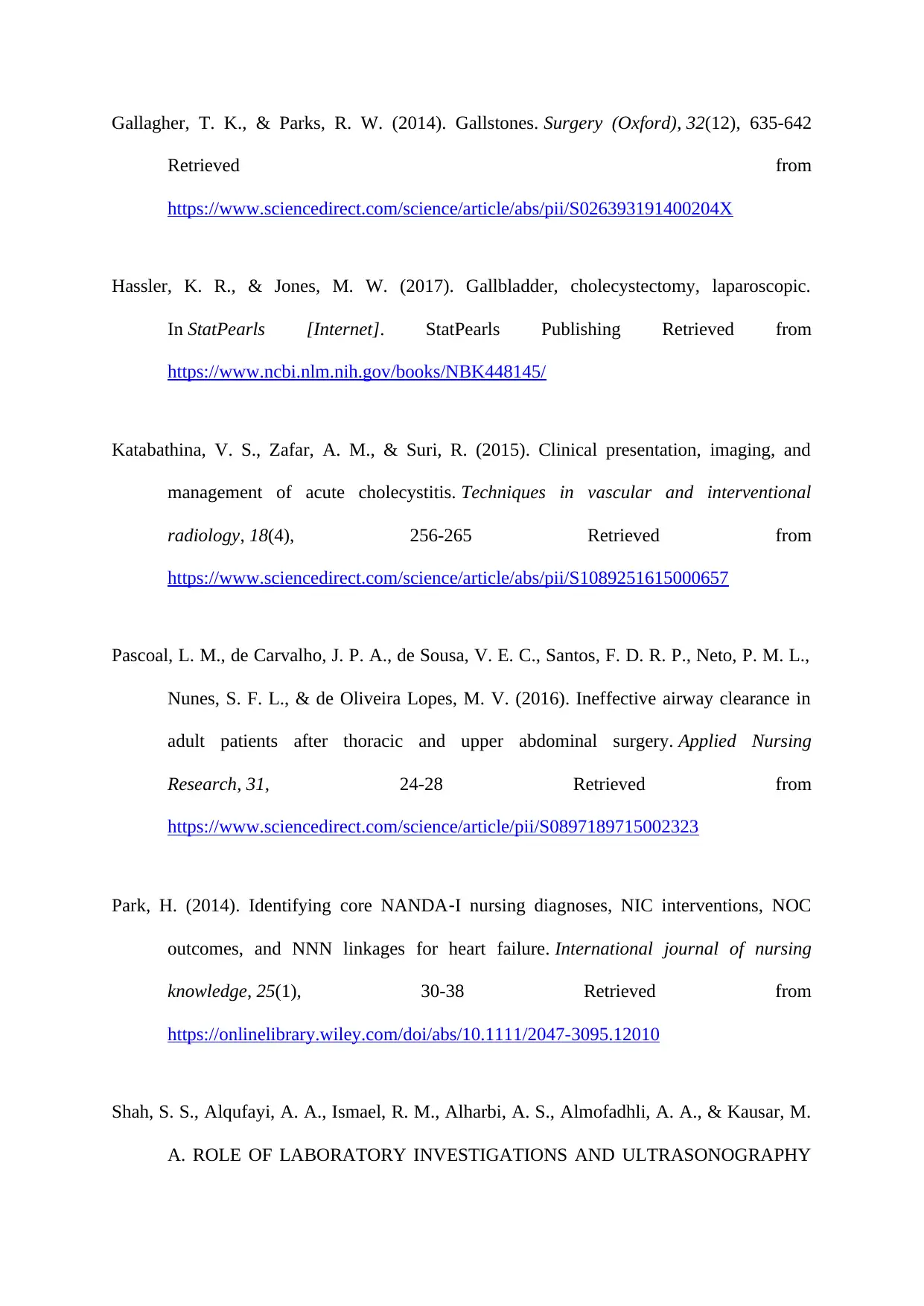
Gallagher, T. K., & Parks, R. W. (2014). Gallstones. Surgery (Oxford), 32(12), 635-642
Retrieved from
https://www.sciencedirect.com/science/article/abs/pii/S026393191400204X
Hassler, K. R., & Jones, M. W. (2017). Gallbladder, cholecystectomy, laparoscopic.
In StatPearls [Internet]. StatPearls Publishing Retrieved from
https://www.ncbi.nlm.nih.gov/books/NBK448145/
Katabathina, V. S., Zafar, A. M., & Suri, R. (2015). Clinical presentation, imaging, and
management of acute cholecystitis. Techniques in vascular and interventional
radiology, 18(4), 256-265 Retrieved from
https://www.sciencedirect.com/science/article/abs/pii/S1089251615000657
Pascoal, L. M., de Carvalho, J. P. A., de Sousa, V. E. C., Santos, F. D. R. P., Neto, P. M. L.,
Nunes, S. F. L., & de Oliveira Lopes, M. V. (2016). Ineffective airway clearance in
adult patients after thoracic and upper abdominal surgery. Applied Nursing
Research, 31, 24-28 Retrieved from
https://www.sciencedirect.com/science/article/pii/S0897189715002323
Park, H. (2014). Identifying core NANDA‐I nursing diagnoses, NIC interventions, NOC
outcomes, and NNN linkages for heart failure. International journal of nursing
knowledge, 25(1), 30-38 Retrieved from
https://onlinelibrary.wiley.com/doi/abs/10.1111/2047-3095.12010
Shah, S. S., Alqufayi, A. A., Ismael, R. M., Alharbi, A. S., Almofadhli, A. A., & Kausar, M.
A. ROLE OF LABORATORY INVESTIGATIONS AND ULTRASONOGRAPHY
Retrieved from
https://www.sciencedirect.com/science/article/abs/pii/S026393191400204X
Hassler, K. R., & Jones, M. W. (2017). Gallbladder, cholecystectomy, laparoscopic.
In StatPearls [Internet]. StatPearls Publishing Retrieved from
https://www.ncbi.nlm.nih.gov/books/NBK448145/
Katabathina, V. S., Zafar, A. M., & Suri, R. (2015). Clinical presentation, imaging, and
management of acute cholecystitis. Techniques in vascular and interventional
radiology, 18(4), 256-265 Retrieved from
https://www.sciencedirect.com/science/article/abs/pii/S1089251615000657
Pascoal, L. M., de Carvalho, J. P. A., de Sousa, V. E. C., Santos, F. D. R. P., Neto, P. M. L.,
Nunes, S. F. L., & de Oliveira Lopes, M. V. (2016). Ineffective airway clearance in
adult patients after thoracic and upper abdominal surgery. Applied Nursing
Research, 31, 24-28 Retrieved from
https://www.sciencedirect.com/science/article/pii/S0897189715002323
Park, H. (2014). Identifying core NANDA‐I nursing diagnoses, NIC interventions, NOC
outcomes, and NNN linkages for heart failure. International journal of nursing
knowledge, 25(1), 30-38 Retrieved from
https://onlinelibrary.wiley.com/doi/abs/10.1111/2047-3095.12010
Shah, S. S., Alqufayi, A. A., Ismael, R. M., Alharbi, A. S., Almofadhli, A. A., & Kausar, M.
A. ROLE OF LABORATORY INVESTIGATIONS AND ULTRASONOGRAPHY
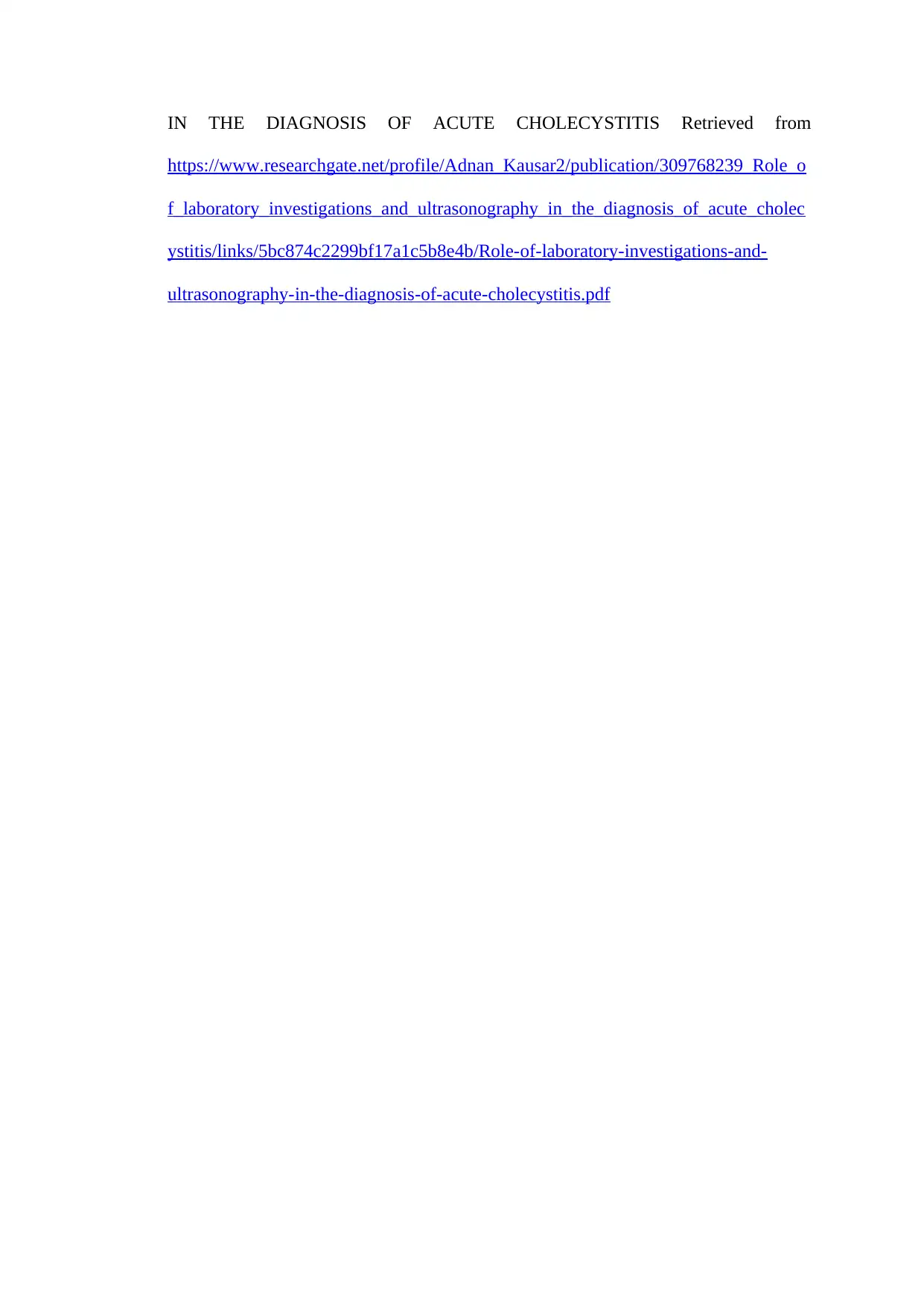
IN THE DIAGNOSIS OF ACUTE CHOLECYSTITIS Retrieved from
https://www.researchgate.net/profile/Adnan_Kausar2/publication/309768239_Role_o
f_laboratory_investigations_and_ultrasonography_in_the_diagnosis_of_acute_cholec
ystitis/links/5bc874c2299bf17a1c5b8e4b/Role-of-laboratory-investigations-and-
ultrasonography-in-the-diagnosis-of-acute-cholecystitis.pdf
https://www.researchgate.net/profile/Adnan_Kausar2/publication/309768239_Role_o
f_laboratory_investigations_and_ultrasonography_in_the_diagnosis_of_acute_cholec
ystitis/links/5bc874c2299bf17a1c5b8e4b/Role-of-laboratory-investigations-and-
ultrasonography-in-the-diagnosis-of-acute-cholecystitis.pdf
1 out of 10
Your All-in-One AI-Powered Toolkit for Academic Success.
+13062052269
info@desklib.com
Available 24*7 on WhatsApp / Email
![[object Object]](/_next/static/media/star-bottom.7253800d.svg)
Unlock your academic potential
© 2024 | Zucol Services PVT LTD | All rights reserved.



